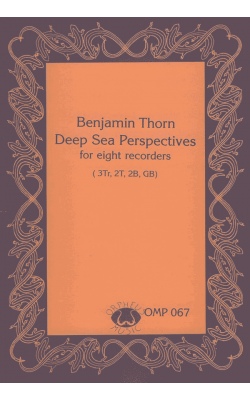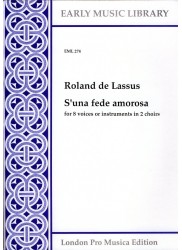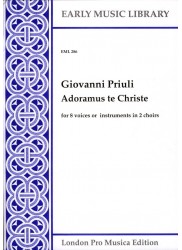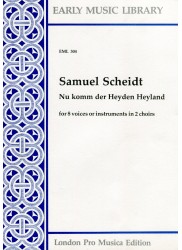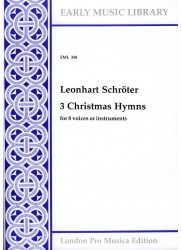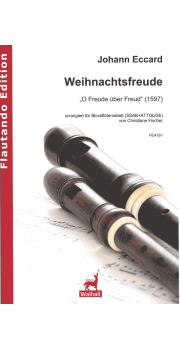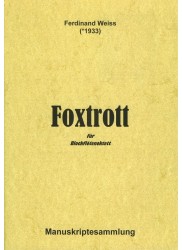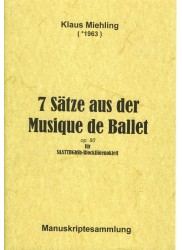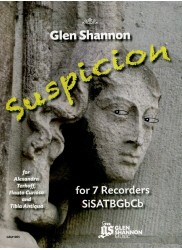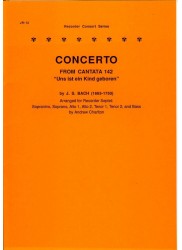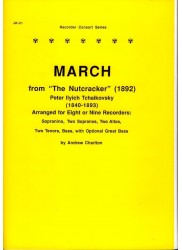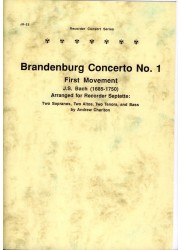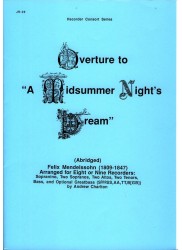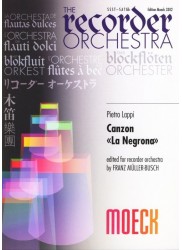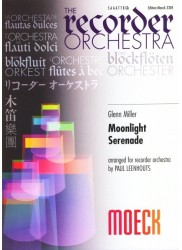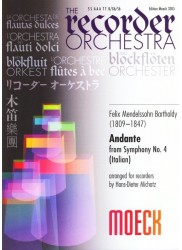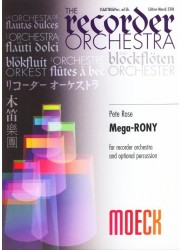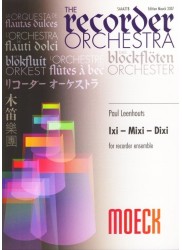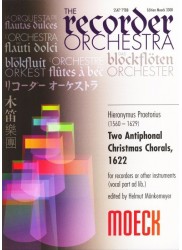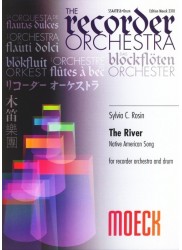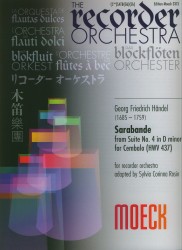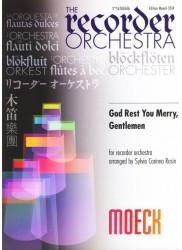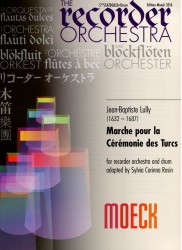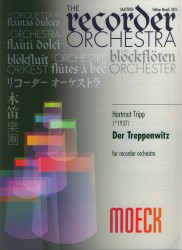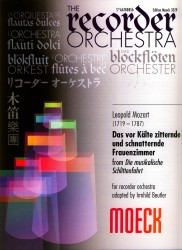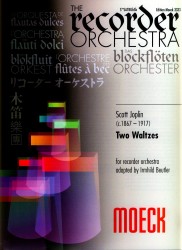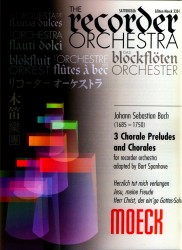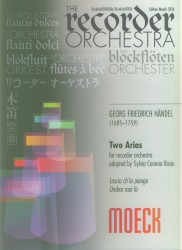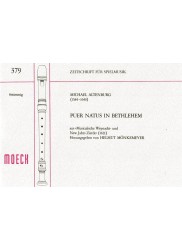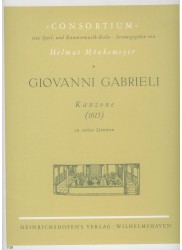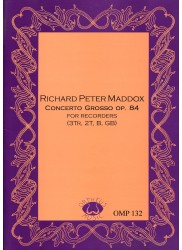No products
Prices are tax included
Deep Sea Perspectives
Composer: Thorn - Benjamin
Instrumentation: 3 Trebles - 2 Tenors - 2 Basses - Greatbass
Period/genre: Australian Contemporary
Grade: Moderate - Difficult
More info
*Contemporary Piece.* Beautifully melodic piece featuring a solo treble that reworks the same musical material in two quite different ways.
1. Deep Sea Perspectives
_Score 19 pp. Parts 4 pp._
OMP067 Benjamin Thorn Deep Sea Perspectives
It is left to the imagination of the performers to decide why this two-movement work is so titled as there is no foreword to give any clues. The opening movement is marked "Gently" and begins with a simple minor key rocking pattern in six-eight time. The texture gradually builds up with the addition of more semiquaver movement in all parts, perhaps depicting the swelling of the sea. There is a definite hint of a concerto grosso to this piece with the top two Treble Recorder parts and Bass 1 getting entire sections on their own as a trio within the octet. While all players have plenty to do, these three parts are particularly active and demand a good degree of fluency in the upper reaches of the instruments. Bass 1 goes up to top F and Treble 1 runs up to top A flat during some of the semiquaver passages. The following Allegro is a lively five-eight movement in C Major, which keeps both players and listeners guessing as the quaver note groupings vary frequently between 3+2 and 2+3. In this movement the sea has evidently woken from its slumber and the choppy quaver movement builds through oscillating semiquavers to a florid cadenza for Treble 1. A return of the opening theme leads to a breathless finale. This challenging work demands technical security and rhythmic confidence from all players but is worth the effort for those who persevere!
Helen Hooker, The Recorder Magazine, Winter 2001
OMP067 Benjamin Thorn Deep Sea Perspectives
Orpheus Music have to be congratulated in encouraging the growth of repertoire in eight or more parts for players of intermediate level, thus offering a wider range of ensemble experience than is usually available. These are contrasting works which both satisfy the need for variety; Thorne¹s pieces contain a thoughtful mixture of rhythmically supported lines and sections which are linearly independent, while Maddox demands a strong sense of pulse and rhythm in a predominantly homophonic texture.
Deep Sea Perspectives is in two contrasting movements; the first is a 6/8 marked Gently; the second a 5/8 marked Allegro. The second has a brief, white-note cadenza for the first treble. Both movements are conventionally written with no changes of time signature and are firmly rooted in their respective tonalities of C minor and C Major. Students will enjoy the range of figuration and changes of role and texture (for example, the basses have a nice little solo in the first movement); they will also enjoy the challenge and rhythmic intensity of the fast 5/8. There is a lot to learn and discuss about phrasing and breathing which are not indicated although, more surprisingly, nor are any dynamics.
Donald Bousted, Cinnamon Sticks, May 2002
OMP067 Benjamin Thorn Deep Sea Perspectives
OMP065 Tony Lewis Zaida Gaire
OMP062 Luigi Irlandini Agnistoma II
Though very different from each other, these ensemble pieces have something in common: their primary difficulty is rhythmic, not technical. Benjamin Thorn's Deep Sea Perspectives is the most accessible of the three. It offers two through-composed movements in a very conservative melodic style with simple tonal harmonies. The first movement, in G minor, is in a gently-flowing 6/7 meter that is not difficult to negotiate. The second movement develops from the same initial motif as the first, but recast in C Major and in a 5/8 meter that is sometimes grouped 3+2, other times 2+3. That wouldn't be terribly hard, were it not for the very fast tempo demanded by Thorn. At crotchet=150, this movement is quite difficult to maintain.
Zaida Gaire by Tony Lewis is a rhythmically-driving and highly-repetitive minimal work in a pan-diatonic language. It sets against each other different melodic/rhythmic patterns, consisting mostly of eighth notes and eighth rests, resulting in an abundance of hockets. While the individual parts may be fairly easy to play by themselves, performing them together is quite a task. This piece requires a great deal of precision and focus.
Luigi Irlandini's Agnistoma II, the least accessible of these works, is uninteresting to play and difficult to execute and conceptualise. The recorders chromatically hover over narrow tessituras, often clashing with each other in intervals of a second. Rhythmically it features an aperiodicity that is generated from tying together odd-shaped rhythmic cells. The rhythmic contours that result from this procedure are extremely complex and precisely notated. They must also be precisely-performed.
These editions are nicely printed and have no bad page turns. Deep Sea Perspectives is suitable for advanced amateurs. Zaida Gaire requires a very high-end amateur group working with a good teacher. Agnistoma II is strictly for professionals.
Pete Rose, American Recorder, March 2003
30 other products in the same category:
Reference: EML274
Brand: Early Music Library
S'una fede amorosa
Composer: Lassus - Orlando de Instrumentation: 2 Descants - 2 Trebles - 2...
In StockReference: EML286
Brand: Early Music Library
Adoramus te Christe
Composer: Priuli - GiovanniInstrumentation: 2 Descants - 2 Trebles - 2 Tenors...
In StockReference: EML304
Brand: Early Music Library
Nun komm der Heiden Heiland
Composer: Scheidt - SamuelInstrumentation: 2 Descants - 2 Trebles - 2 Tenors...
In StockReference: EML358
Brand: Early Music Library
3 Christmas Hymns
Composer: Schroter - Leonhard Instrumentation: 2 Descants - 2 Trebles - 2...
In StockReference: FEA161
Brand: Flautando Edition
Weihnachtsfreude "O freude über freud"
Composer: Eccard - Johannes Instrumentation: 2 Descants - 2 Trebles - 2...
In StockReference: FEMSFW-1
Brand: Manuskriptesammlung
Foxtrott
Composer: Weiss - FerdinandInstrumentation: 2 Descants - 2 Trebles - 2 Tenors...
In StockReference: FEMSKM-3
Brand: Manuskriptesammlung
7 Satze aus der Musique de Ballet Op 80
Composer: Miehling - KlausInstrumentation: Descant - 2 Trebles - 2 Tenors -...
In StockReference: GSM1005
Brand: Glen Shannon Music
Suspicion
Composer: Shannon - Glen Instrumentation: Sopranino - Descant - Treble -...
In StockReference: JR12
Brand: Jolly Robin Press
Concerto from Cantata 142, "Uns ist ein Kind geboren"
Composer: Bach - Johann SebastianArranger: Andrew CharltonInstrumentation:...
In StockReference: JR21
Brand: Jolly Robin Press
March from The Nutcracker
Composer: Tchaikovsky - Pyotr IlyichArranger: Andrew CharltonInstrumentation:...
In StockReference: JR22
Brand: Jolly Robin Press
Brandenburg Concerto No 1, 1st movement
Composer: Bach - Johann Sebastian Arranger: Andrew Charlton...
In StockReference: JR26
Brand: Jolly Robin Press
Overture to "A Midsummer Night's Dream"
Composer: Mendelssohn - FelixArranger: Andrew CharltonInstrumentation:...
In StockReference: M3302
Brand: Moeck
Canzon "La Negrona"
Composer: Lappi - Pietro Arranger: Franz Muller-Busch Instrumentation: 2...
In StockReference: M3304
Brand: Moeck
Moonlight Serenade
Composer: Miller - Glenn Arranger: Paul Leenhouts Instrumentation: Descant...
In StockReference: M3305
Brand: Moeck
Andante from Symphony no 4 (Italian)
Composer: Mendelssohn - Felix Arranger: Hans-Dieter Michatz...
In StockReference: M3307
Brand: Moeck
Ixi-Mixi-Dixi
Composer: Leenhouts - Paul Instrumentation: Descant - 3 Trebles - 2 Tenors -...
In StockReference: M3308
Brand: Moeck
Two Antiphonal Christmas Chorals, 1622
Composer: Praetorius - Hieronymus Arranger: Ed Helmut Monkemeyer...
In StockReference: M3310
Brand: Moeck
The River: Native American Song
Composer: Rosin - Sylvia Corinna Instrumentation: 2 Descants - 2 Trebles -...
In StockReference: M3313
Brand: Moeck
Sarabande from Suite No 4 in d minor (HWV 437)
Composer: Handel - Georg Friedrich Arranger: Sylvia C Rosin...
In StockReference: M3314
Brand: Moeck
God Rest You Merry, Gentlemen
Composer: Traditional Arranger: Sylvia C Rosin Instrumentation: Sopranino -...
Out of stockReference: M3316
Brand: Moeck
Marche pour la Ceremonie des Turcs
Composer: Lully - Jean-Baptiste Arranger: Sylvia C Rosin Instrumentation:...
In StockReference: M3325
Brand: Moeck
Der Treppenwitz
Composer: Tripp - Hartmut Instrumentation: Descant - 2 Trebles - 2 Tenors -...
In StockReference: M3329
Brand: Moeck
Das vor Kalte zitternde und schnatternde Frauenzimmer from "Die musikalische...
Composer: Mozart - Leopold Arranger: Irmhild Beutler Instrumentation:...
In StockReference: M3333
Brand: Moeck
Two Waltzes
Composer: Joplin - Scott Arranger: Irmhild Beutler Instrumentation:...
In StockReference: M3334
Brand: Moeck
Three Chorale Preludes and Chorales
Composer: Bach - Johann Sebastian Arranger: Bart Spanhove Instrumentation:...
Out of stockReference: ZFS379
Brand: Moeck
Puer Natus in Bethlehem
Composer: Altenburg - Michael Arranger: Helmut Monkemeyer Instrumentation:...
$10.95 -30%In StockReference: N1128
Brand: Noetzel
Canzone a 7
Composer: Gabrieli - GiovanniInstrumentation: 2 Descants - 2 Trebles - 2...
In StockReference: OMP132
Brand: Orpheus Music
Concerto Grosso Op 84 for recorders
Composer: Maddox - Richard Peter Instrumentation: 3 Trebles - 2 Tenors -...
In Stock

